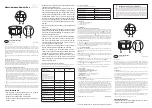MCF5441X Tower Module Hardware Specification
Page 14 of 31
o
IRQ1 (SW3)
o
IRQ2 (SW5)
o
MCU reset (SW2)
One 8-way DIP switch for controlling Parallel Reset Configuration
One 2-way DIP Switch for additional GPIOs (Assuming BDM DDATA[3:2] are disabled).
Four LEDs driven directly by MPU output pins.
The LEDs are concurrently connected to the LED’s and the edge connector for GPIO access to external
Tower System modules. If required the signals from the MCF54418 can be disconnected from either
the LED’s or the TWR-ELEV GPIO’s. The connection to the LEDs is made between pads 1 and 2. The
connection to the TWR-ELEV GPIO’s is made between pads 1 and 3. Refer to the table below for
details regarding which signal corresponds to which LED and TWR-ELEV GPIO.
MCF54418
Signal Name
LED
TWR-ELEV GPIO
Configuration
Cut-Trace Pad
GPIO_G0
LED1 (Amber)
GPIO9 (A9)
CT3
GPIO_G1
LED2 (Yellow)
GPIO7 (A11)
CT6
GPIO_G2
LED3 (Green)
GPIO1 (B21)
CT9
GPIO_G3
LED4 (Orange/Red)
GPIO5 (B52)
CT7
For more details regarding the Cut-Trace pad options and the pad numbering refer to the Cut-Trace
Pad section of this document.
4.13
Reset Configuration
The TWR-MCF5441X has three boot mode options:
Boot with default configuration constants specified in the RCON register
Boot with NAND/NOR with configuration data specified by the Flexbus FB_AD[7:0] pins
Boot with configuration data obtained from an external SPI memory through the serial boot
facility.
The boot modes are determined by the jumper configuration of J5 at reset. Placing a jumper on pins
1-2 of J5 causes BOOTMOD[0] to be low (0). Placing a jumper on pins 3-4 of J5 causes BOOTMOD[1] to
be low (0). In the table below “ON” implies that the respective jumper is shunted.


















